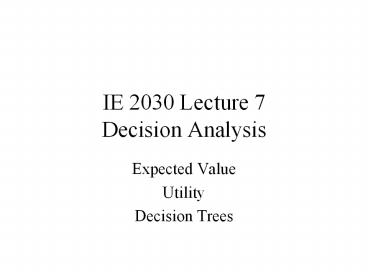IE 2030 Lecture 7 Decision Analysis - PowerPoint PPT Presentation
Title:
IE 2030 Lecture 7 Decision Analysis
Description:
IE 2030 Lecture 7 Decision Analysis Expected Value Utility Decision Trees Topics Today IE 2030 Lecture 7 Introduction to PERT Decision tree example: party planning ... – PowerPoint PPT presentation
Number of Views:158
Avg rating:3.0/5.0
Title: IE 2030 Lecture 7 Decision Analysis
1
IE 2030 Lecture 7Decision Analysis
- Expected Value
- Utility
- Decision Trees
2
Topics Today IE 2030 Lecture 7
- Introduction to PERT
- Decision tree example party planning
- Concepts
- Uncertainty
- Minimax Criterion
- Expected Value Criterion
- Risk Aversion
- Risk Neutral, Risk Averse, Risk Seeking
- Utility
- Outcome and Decision
- Decision Tree
- Value of information
- Sensitivity analysis
3
Party Example (R. Howard)
900
Clear .6
Rain .4
100
OUT
IN
600
Clear .6
Rain .4
500
4
Decision Trees
- Use different shapes for decisions and uncertain
branchings - Compute from the leaves back to the root
- Use expected values
- When you make a decision, you know the history,
the path from the root to the decision point
5
Minimax or Maximin Criterion
- Choice to make worst possible outcome as good as
possible - Usually gives poor decisions because excessively
risk averse - Fearful people use this criterion
- Are you afraid of being judged badly afterwards?
- Decisions vs. Outcomes
Probability of regret
6
Maximin and other Payoff Criteria
- Who is your opponent?
- An indifferent Nature
- use probability, consider expected value
- A hostile or vengeful Fate...
- Use Maximin, consider a psychiatrist
- A self-interested person
- use game theory and economics
- A hostile person who desires your failure...
- use game theory, maximin, consider an
intermediary or arbitrator
7
Never attribute to malice, what can be adequately
explained by stupidity
Trust and Credibility
8
Risk aversion
- Choice of sure thing versus lottery
- Size
- Gain or loss
- Expected value criterion
- Utility
9
It is expensive to be poor
- Companies dont like to risk going out of
business - Wealthier people can afford to gamble
- get higher average returns
- We model this by setting very low utility values
on outcomes below danger threshholds - Can cause problems in environmental decisions.
Is going bankrupt as bad as destroying the
worlds ecology?
10
Decision Analysis Value of Information (based on
R. Howards notes)
900
out
Clear .6
in
600
Rain .4
100
out
in
500
11
Value of Information
- Expected value of a clairvoyant (perfect
information) is an upper bound on the value of
any forecast - Analysis assumes your probabilities are correct
- Must use conditional probability to find
probabilities of imperfect forecasts
12
Forecast probabilities simple example
- Consistently 90 accurate forecast whatever the
forecast, it is correct w.p..9 - If it rains 50 of the time, forecast rain w.p.
.5 - If it rains 90 of time, forecast rain w.p. 1
- If it rains 100 of time, consistent 90 accuracy
is impossible - Many forecasts have inconsistent accuracy
13
Forecast probabilities party example
- Consistently 90 accurate forecast whatever the
forecast, it is correct w.p..9 - If it rains 40 of time, forecast rain w.p. q.
- .9q .1(1-q) 0.4
- LHS Prob(rain), calculated over event
partition predict rain, dont predict rain - You must decide what to do for each possible
forecast - What if the forecast were 0 accurate?































